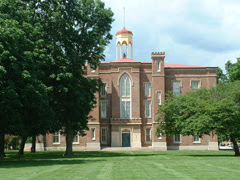 The Illinois Bureau of Tourism is trying to determine the Seven Wonders of Illinois. The state has been divided into seven areas with distinct attractions listed for each area. Visitors to the web site are invited to vote for their favorites once a day from March 5th through March 31st. Each week the field of attractions will be reduced by one in each area until only one remains; the remaining attractions will become the official Seven Wonders of Illinois.
The Illinois Bureau of Tourism is trying to determine the Seven Wonders of Illinois. The state has been divided into seven areas with distinct attractions listed for each area. Visitors to the web site are invited to vote for their favorites once a day from March 5th through March 31st. Each week the field of attractions will be reduced by one in each area until only one remains; the remaining attractions will become the official Seven Wonders of Illinois.
I’m a Midwestern girl and have visited Illinois many times. It’s a great state with lots to offer. I’ve always enjoyed my time there, even the time I was caught in a storm that felled trees in front of and behind my car, stranding me on the road for several hours while crews worked to reopen the byway.
Many people know Illinois as The Land of Lincoln or the home of the metropolis called Chicago. It is also a place with a fair amount of Mormon history. On one trip I made to Illinois, to take my mother to see Lincoln’s Tomb, we first toured the city of Galena and learned that the post office was partially constructed of stones from the first Mormon temple (destroyed in the 1840s) 100 miles downriver at Nauvoo, Illinois. When we reached Springfield, visiting the law office of Abraham Lincoln and attached courtroom, we learned that Joseph Smith, the Mormon Prophet, had appeared in that very courtroom to face charges in the attempted murder of former Missouri Governor Lilburn Boggs. Mr. Lincoln did not defend Joseph Smith; Mr. Lincoln had nothing to do with the event in question. It was just a bit of trivia offered by the museum’s docent. My mother, rather advanced in years and perhaps grown a bit testy, turned to me in frustration and asked, “Why are they talking about Mormons everywhere we go?”
I suppose the answer is that Mormons made a significant impact on the state in their short time there. The excellent book Cultures in Conflict: A Documentary History of the Mormon War in Illinois offers this concise explanation (from the book’s jacket):
Cultures in Conflict chronicles the rise of a theocratic [Mormon] kingdom at Nauvoo, the increasingly strident response of non-Mormons, the repression of dissident Mormons at Nauvoo, the famous double murder of Joseph and Hyrum Smith at Carthage [Illinois], the subsequent civil war in Hancock County, and the forced exodus of the Mormons from Illinois. Especially important is the historical information on the often overlooked two-year period between the Smith murders and the departure for the West of the majority of Mormons. For a tense seven years, Mormon Church members contended with their neighbors over a variety of political, economic, religious, and social issues. Between 1839 and 1846 the Mormons created a powerful and largely autonomous theocratic state at Nauvoo that clashed with the republican values of frontier non-Mormons. Mormons came to see themselves as persecuted innocents acting righteously in accordance with God’s will, but non-Mormons saw them instead as threats to democratic institutions and the rule of the law.
Nauvoo is one of the attractions in the running for the Seven Wonders of Illinois. I’d be tempted to vote for it if I thought its background would be fully and accurately related to visitors. There’s much to be learned from the slice of American history that transpired there.
However, Nauvoo is currently nothing but a faith-promoting tool for the LDS Church. The “history” presented is carefully constructed, stripped of all content and context that would provide a true understanding of what really happened there in the nineteenth century. Amidst family-friendly activities and demonstrations of pioneer life, the LDS missionaries staffing each of almost 50 sites in Nauvoo make certain visitors understand the most important thing: that the Mormon pioneers were totally innocent victims of bigoted persecution.
Nothing happens in a vacuum; accurate, inclusive history reveals a very different story of Mormon Nauvoo than the LDS Church likes to tell. Personally, I love history and believe the triumphs and mistakes of those who have gone before us share equal importance. Adlai Stevenson said, “We can chart our future clearly and wisely only when we know the path which has led us to the present.” Propagandized Mormon history is neither helpful nor deserving of Illinois’ promotion.
 As it is, Old Main at Knox College, “the only building remaining from the landmark Lincoln-Douglas senatorial debates…on the grounds where Stephen Douglas and Abraham Lincoln debated the issue of slavery” is the site in western Illinois that will get my vote as one of the state’s worthy Seven Wonders.
As it is, Old Main at Knox College, “the only building remaining from the landmark Lincoln-Douglas senatorial debates…on the grounds where Stephen Douglas and Abraham Lincoln debated the issue of slavery” is the site in western Illinois that will get my vote as one of the state’s worthy Seven Wonders.

Sharon, I read this awhile ago and then kept thinking about it. Recently I learned that my daughter, a mormon not a resident of Illinois voted in this event. She was made aware of it through the church which tells me that there is little doubt about the winner if the LDS folks are doing most of the voting.